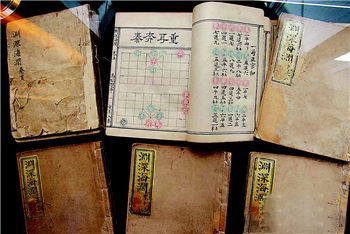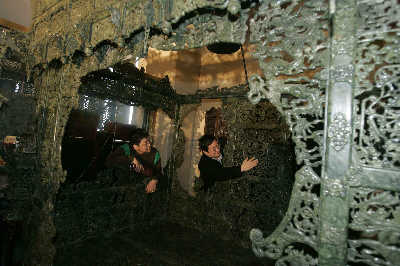Artistic Jewelry Shining with Charm
Updated: 2007-07-25 08:39
The Chinese chess manual scripts "Deep Pool, Infinite Sea"

The Qing Dynasty (Chinese) chess manual scripts represent a huge collection of the cream of ancient chess games and well-known, knotty chess games collected and sorted out by author Chen Wenqian for 17 consecutive years, and he finally completed the copying in 1808. The entire work is divided into 16 volumes with a total of 371 famous chess games. But to date, there is one work only extant, as Chen was too poor to have it printed at that time.
The collection of chess games emerged abruptly in 1933 after having sunken into oblivion for more than a century. Then, an ace Chinese chess game player in north China's Hebei province , Qian Mengwu, chanced on it but he failed to get it as its owner asked a higher price than he could pay. Through the maneuvering of his friend, however, he succeeded in borrowing it and got his chess pals to hurry through its copying overnight.
About 30 years later, another chess start Liu Guobin on July 30, 1964 found the chess manual scripts collection with the introduction of an acquaintance at the China Bookstore. Then, he pawned a Swiss-made watch and bought the chess manual scripts with 150 yuan (some 20 dollars) he got from the watch's sale. Grand chess master Qian Mengwu confirmed it afterwards as the very work he had borrowed and copied with the help of his chess pals three decades earlier.
Xiuyan Jade Dragon Bed

On January 16, curio collector Yang Zhibin from the city of Banjin in northeastern Liaoning province showed to his visitors the modern-age Xiuyan jade bed. The jade bed, in dark green, is 305 centimeters long, 165 centimeters wide and 280 centimeters in height, typical of furniture style in the late Qing dynasty. It is carved with varied flower designs as well as the designs of dragon scales resembling those on the imperial throne of the Qing court. Moreover, it is carved with dragons and phoenixes, and the happiness-longevity symbols, with bedside "palace" jade lamps, of superb craftsmanship.
The jade bed, which was made out of four tons of rare jade material, would take at least three full years to complete, provided it involved a total of 10 workers, with each working 10 hours a day, archaeologists and experts estimated.
As soon as Yang Zhibin saw a picture of the jade bed, he made up his mind to
buy the invaluable asset at all costs. Finally he purchased it and hired eight
craftsmen to assemble it with 15 cases of material he bought, and it took them
six full days to get the job done.
 | 1 | 2 | 3 |  |

